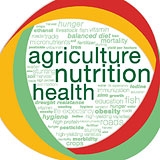Chris Addison writes:
To accommodate a complete change in the way we use the Internet to find information and stay in touch, a new and different strategy for online publishing is essential. At IFPRI, we have been experimenting with the concept of a “3-D” approach using (1) decentralized content, (2) a descriptive system to put information in context, and (3) ways to ensure we are part of the discussion.
So, we have been looking at our work through 3-D glasses, and it has brought the system vividly to life.
1. DecentralizeFirst, we have begun to decentralize what we do by moving from a “one-platform-fits-all” approach to one that encourages the most appropriate platforms for particular types of content. Individuals, projects, divisions, and departments in the organization need to be able to update information online, so the ability to input data and documents cannot rest solely with one group. We make extensive use of
Slideshare and
YouTube whenever content is photo- or video-based. To post short communications, we use Wordpress, which we also use to create “
websites on the fly.” Our publications follow an open-access workflow that ensures they are published on the IFPRI website and stored on the server
repository to be accessible to all.
The decentralization also applies to how our content reaches our audience. We have turned the core IFPRI website into a web engine able to produce content feeds, which can be used by others. These feeds are now one of the top sources of traffic to our website. We are also rapidly moving toward providing content that can be embedded elsewhere, as is the case with the Global Hunger Index map.
2. Describe
Since our content is now so well dispersed in different platforms, it is essential to link related items through a descriptive system so that information is displayed in context. Therefore, indexing materials online becomes ever more important to ensure that all related material can be readily linked, embedded, remixed, and reused. It isn’t always possible, however, to manually index all materials, so we use a Google custom search to cover our presentations, photos, and videos on Slideshare, Flickr, and YouTube, respectively. The tagging of items on social media sites also allows us to more easily connect different platforms—for example, integrating satellite sites and portals with the main website—and ensure that others can embed or display our content on their own sites.
3. Discuss
One of the biggest changes with online information continues to be the ability to listen to our audience and discuss issues with them instead of just pushing information at them from our own website. This means engaging in ongoing dialogues through Twitter, Facebook, and LinkedIn. It means contributing content to Wikipedia, which continues to be a reference source for our targeted audience. We see that other industries are developing “web-care teams” to better listen to their customers, drive development, and gain knowledge, in the same way we monitor what the community is saying about our issues and our work. Open discussion allows civil society to participate in the shaping of international development; it democratizes the system and the sector. We are already seeing discussion-based results with Twitter, for example, which allows people to provide both anecdotal and substantial feedback on the issues we are researching.
These ideas on a “3-D” system of online publishing, were presented at the United States Agricultural Information Network (USAIN) meeting earlier in the year and we would be interested in hearing from colleagues in IAALD as to whether they have had similar experiences.
Labels: aginfo, cgiar, en, ifpri, web2.0, websites



 A side event at this weeks IFPRI conference '
A side event at this weeks IFPRI conference '



